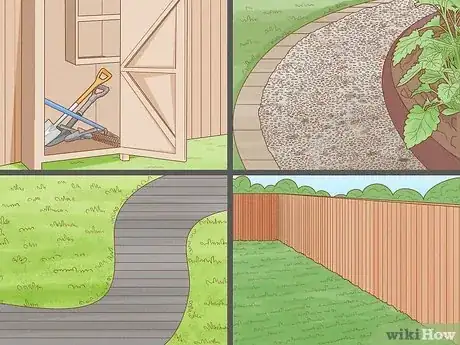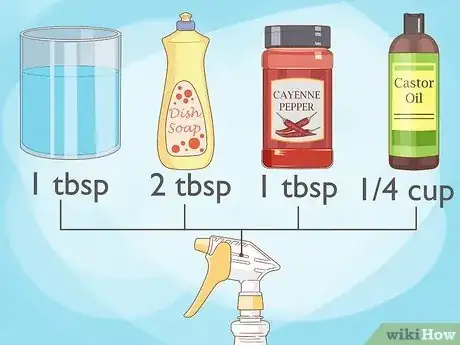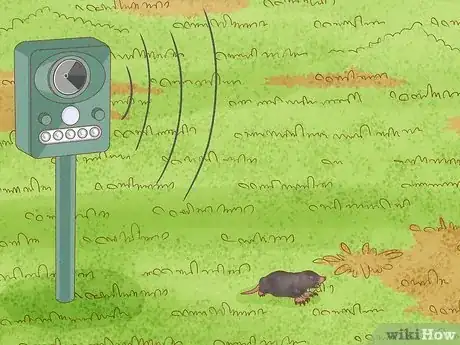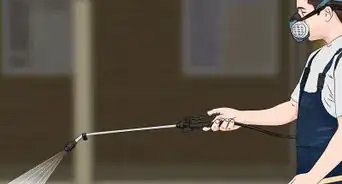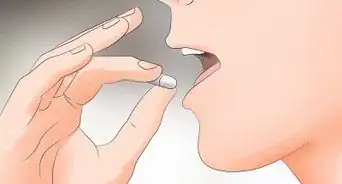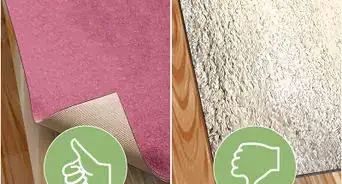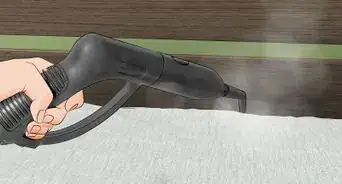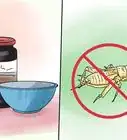This article was co-authored by Chris Parker. Chris Parker is the Founder of Parker Eco Pest Control, a sustainable pest control service in Seattle, Washington. With over seven years of experience, Chris specializes in Integrated Pest Management and doesn’t use any chemicals for pest removal. He offers removal services for ants, rodents, fleas, spiders, wasps, and more. Chris is a certified Commercial Pesticide Applicator in Washington State and received his bachelor’s from the University of Washington.
There are 7 references cited in this article, which can be found at the bottom of the page.
This article has been viewed 36,470 times.
Moles are common garden pests that are found all over the world. Evidence of a mole in your yard may include dirt mounds, raised ridges, and soft, spongy soil. Actual moles rarely move above ground, but may be spotted in spring or fall, morning or evening, and after a warm rain. Once you confirm the presence of moles, you can get rid of them harmlessly by making a homemade repellent spray, buying a sonic pulse mole repeller, or building a mole barrier under the ground.
Steps
Checking for Evidence of Moles
-
1Look for mounds of dirt. If you suspect that you might have moles in your garden, look for mounds of dirt on the surface of your grass. Moles will typically leave heaps of dirt the size of baseballs or softballs when tunneling. Check daily as these mounds can appear quickly as moles make their way through the yard.[1]
- A typical mole might make between 50-100 mounds in a single month.
EXPERT TIPSteve Masley has been designing and maintaining organic vegetable gardens in the San Francisco Bay Area for over 30 years. He is an Organic Gardening Consultant and Founder of Grow-It-Organically, a website that teaches clients and students the ins and outs of organic vegetable gardening. In 2007 and 2008, Steve taught the Local Sustainable Agriculture Field Practicum at Stanford University.Home & Garden Specialist
 Steve Masley
Steve Masley
Home & Garden SpecialistMoles burrow around your yard to make tunnels. You'll see raised mounds of dirt meandering around your yard when you have a mole. They often dig up seedlings and loosen the soil, but they usually eat worms and insects.
-
2Check for tunnels. Moles tunnel deep into the ground, usually at least 10 inches under the surface. If you notice raised swellings of earth under the grass in your garden, try stepping on it lightly. If the ground gives away under your foot, this is a strong indication that you have moles.[2]Advertisement
-
3Inspect borders. Moles tend to dig alongside structures, tunneling below the surface. Check along your house foundation and driveway for shallow moles runs, evidenced by raised ridges and mounds. Other structures to check the borders of should include:
- Walkways
- Lawn borders
- Garden sheds
- Fences
-
4Keep checking. If evidence of moles in your garden subsides, keep checking for evidence for the next few months. When the supply of insects in the upper soil becomes scarce, moles will simply dig deeper and leave less evidence than they do when digging shallow tunnels. Moles may even use dirt from their mounds to fill in old tunnels while digging in deeper soil, giving you the false impression that they have left your yard.
-
5Look at pictures of moles. Look online for pictures of moles to know exactly what you are looking for in your yard. They are small mammals with front flippers, webbed feet, no visible ears, and a pointed, bald snout. Moles are typically only 7 inches long (approximately 18 cm) and weigh about 4 pounds.[3]
-
6Observe your yard. Moles are most active in the spring or fall. To spot one, observe your yard in the early morning or evening. While moles only tend to appear above ground surface when they are looking for a mate, you might observe active signs of their tunnelling (e.g. dirt being tossed, grass moving).[4]
- Moles are also likely to appear outdoors after a warm rain, when things are moist and temperate.
Getting Rid of Moles Harmlessly
-
1Make a natural mole repellent spray. To make a harm-free, mole repelling spray, combine 1/4 cup (2 oz) of castor oil, 1 tbsp. (0.5 oz) of cayenne pepper, and 2 tbsp. of liquid dish detergent in a large bowl or container. Add 1 tbsp. (0.5 oz) of water and stir, then pour the mixture in a container to store. When needed, mix 2 tbsp. (1 oz) of the mixture to a gallon of water and fill a spray bottle. Spray mounds, raised ridges, and the surrounding area of your yard.[5]
- Castor oil, a powerful mole repellent, can also be effective when applied to the soil on its own.
-
2Try an ultrasonic device. Another harm-free mole deterrent option might be an ultrasonic device emitting an underground sonic pulse to repel moles and other underground rodents (e.g. gophers). The penetrating vibrations will not affect you or your house pets, but will effectively deter pests from tunneling nearby. The Molechaser, for instance, is a small, waterproof, battery-operated spike that can be inserted into the ground to repel underground rodents, and is available online for approximately $25.[6]
-
3Use a humane trap. Find an active mole tunnel in your garden and dig to widen one of its entrance holes enough to fit a live trap in. Monitor the trap closely to make sure that the mole does not stay trapped inside too long. Drive the mole, still in the trap, at least 5 miles away from your home before releasing it to relocate it.[7]
Preventing Garden Moles
-
1Build an underground barrier. Thwart mole tunneling by digging an obstructive trench in your yard. Dig down about 2 feet deep and 6 inches (approximately 15 cm) wide to cover enough area to have an impact. Fill this trench with impenetrable material likes rock or concrete, or fill it with wire.[8]
- This is an effective but labor-intensive way to protect your flower or vegetable garden from moles.
-
2Get rid of grubs. If you have a mole problem in your garden, it is likely that you have a large concentration of grubs, which moles eat. To prevent moles, get rid of their potential food source by spraying your garden with milky spore disease or beneficial nematodes, available online or in garden stores. Neither will harm your plants or lawn, but they will kill grubs that would draw moles to your yard.[9]
-
3Get an outdoor-friendly cat. To prevent moles, consider getting a cat to walk around your garden. Cats are deterrents to rodents of all kinds and will dissuade moles (and other pests) from wandering into your yard. Before adopting or buying a cat, make sure that your backyard is securely fenced in and free of any plants that might be poisonous to cats if ingested.[10]
- For a list of plants that are poisonous to pets, visit the Humane Society website.
Expert Q&A
Did you know you can get expert answers for this article?
Unlock expert answers by supporting wikiHow
-
QuestionWhat is the fastest way to get rid of moles in your yard?
 Chris ParkerChris Parker is the Founder of Parker Eco Pest Control, a sustainable pest control service in Seattle, Washington. With over seven years of experience, Chris specializes in Integrated Pest Management and doesn’t use any chemicals for pest removal. He offers removal services for ants, rodents, fleas, spiders, wasps, and more. Chris is a certified Commercial Pesticide Applicator in Washington State and received his bachelor’s from the University of Washington.
Chris ParkerChris Parker is the Founder of Parker Eco Pest Control, a sustainable pest control service in Seattle, Washington. With over seven years of experience, Chris specializes in Integrated Pest Management and doesn’t use any chemicals for pest removal. He offers removal services for ants, rodents, fleas, spiders, wasps, and more. Chris is a certified Commercial Pesticide Applicator in Washington State and received his bachelor’s from the University of Washington.
Founder, Parker Eco Pest Control
-
QuestionWhat is the best mole repellent?
 Chris ParkerChris Parker is the Founder of Parker Eco Pest Control, a sustainable pest control service in Seattle, Washington. With over seven years of experience, Chris specializes in Integrated Pest Management and doesn’t use any chemicals for pest removal. He offers removal services for ants, rodents, fleas, spiders, wasps, and more. Chris is a certified Commercial Pesticide Applicator in Washington State and received his bachelor’s from the University of Washington.
Chris ParkerChris Parker is the Founder of Parker Eco Pest Control, a sustainable pest control service in Seattle, Washington. With over seven years of experience, Chris specializes in Integrated Pest Management and doesn’t use any chemicals for pest removal. He offers removal services for ants, rodents, fleas, spiders, wasps, and more. Chris is a certified Commercial Pesticide Applicator in Washington State and received his bachelor’s from the University of Washington.
Founder, Parker Eco Pest Control
-
QuestionCan I remove a mole myself?
 Chris ParkerChris Parker is the Founder of Parker Eco Pest Control, a sustainable pest control service in Seattle, Washington. With over seven years of experience, Chris specializes in Integrated Pest Management and doesn’t use any chemicals for pest removal. He offers removal services for ants, rodents, fleas, spiders, wasps, and more. Chris is a certified Commercial Pesticide Applicator in Washington State and received his bachelor’s from the University of Washington.
Chris ParkerChris Parker is the Founder of Parker Eco Pest Control, a sustainable pest control service in Seattle, Washington. With over seven years of experience, Chris specializes in Integrated Pest Management and doesn’t use any chemicals for pest removal. He offers removal services for ants, rodents, fleas, spiders, wasps, and more. Chris is a certified Commercial Pesticide Applicator in Washington State and received his bachelor’s from the University of Washington.
Founder, Parker Eco Pest Control
References
- ↑ http://www.mnn.com/your-home/organic-farming-gardening/stories/how-to-get-rid-of-moles-in-your-yard
- ↑ http://www.almanac.com/pest/moles
- ↑ http://www.almanac.com/pest/moles
- ↑ http://www.almanac.com/pest/moles
- ↑ http://www.improvementscatalog.com/RoomForImprovements/get-rid-moles-using-home-remedies/
- ↑ https://www.planetnatural.com/product/sonic-molechaser/
- ↑ http://www.almanac.com/pest/moles
- ↑ https://www.planetnatural.com/pest-problem-solver/lawn-pests/mole-control/
- ↑ http://www.almanac.com/pest/moles


